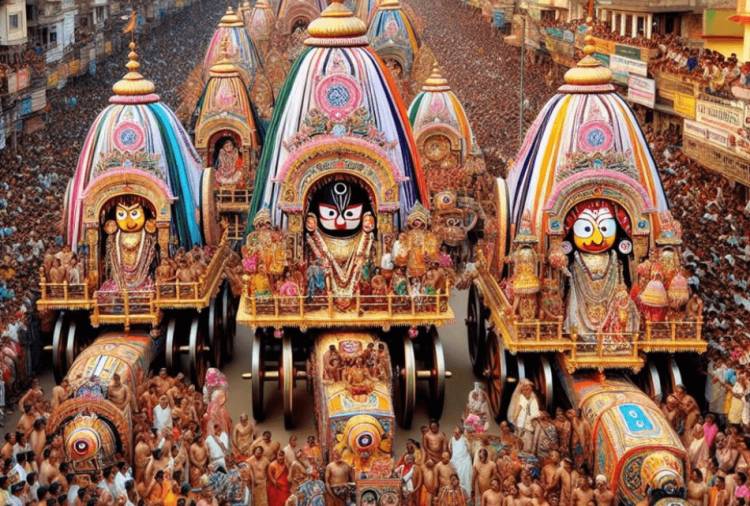Shree Jagannath Rath Yatra: A Journey of Faith and Tradition

Shree Jagannath Rath Yatra: A Journey of Faith and Tradition
The Jagannath Rath Yatra, also known as the Chariot Festival, is one of the most celebrated and grand festivals in India. Held annually in Puri, Odisha, it attracts millions of devotees from all over the world. This vibrant and spiritually uplifting event is steeped in history, mythology, and cultural significance, making it a unique and cherished tradition.
All three chariots are made of wood and beautifully decorated by local artists. Lord Jagannath’s chariot is the largest, with 16 big wheels and a height of 44 feet. Lord Balabhadra’s chariot has 14 wheels and is 43 feet tall, while Goddess Subhadra’s chariot has 12 wheels and stands 42 feet tall. These chariots are pulled by hand using 50-meter-long ropes. People eagerly help pull the chariots because they believe it brings them blessings and helps make up for their mistakes. During the Puri Rath Yatra, Lord Balabhadra’s chariot is pulled first, followed by Goddess Subhadra’s, and finally Lord Jagannath’s.
History and Origin
The history of the Jagannath Rath Yatra dates back centuries. It is believed to have started in the 12th century, though references to Lord Jagannath can be found in ancient Hindu scriptures. The festival is primarily dedicated to Lord Jagannath, a form of Lord Krishna, along with his siblings, Balabhadra (Balarama) and Subhadra.
The grand temple of Jagannath in Puri, where the deities reside, was built by King Anantavarman Chodaganga Deva of the Eastern Ganga dynasty. The Rath Yatra itself is believed to have been initiated by King Indradyumna, a legendary king who, according to mythological tales, was instructed by Lord Vishnu in a dream to build the temple and start the chariot festival.
Mythological Beliefs
The Jagannath Rath Yatra is deeply rooted in Hindu mythology. According to legend, Lord Jagannath, Balabhadra, and Subhadra express their desire to visit their birthplace, Gundicha Temple, which is located a few kilometers away from the main temple in Puri. The Rath Yatra symbolizes this journey.
Another belief associated with the festival is that the deities come out of their temple to give darshan (viewing) to all devotees, including those who cannot enter the temple. This gesture signifies the gods' love and compassion for all people, regardless of their caste, creed, or social status.
The Festival
The Rath Yatra takes place during the Hindu month of Ashadha (June-July). The main event involves the deities being placed on gigantic, beautifully decorated chariots, which are then pulled by thousands of devotees. The chariots are massive, with Lord Jagannath's chariot being the largest, known as Nandighosha, followed by Balabhadra's chariot called Taladhwaja, and Subhadra's chariot known as Darpadalana.
The journey begins from the Jagannath Temple and ends at the Gundicha Temple, where the deities stay for nine days before returning to the main temple in another procession known as Bahuda Yatra.
Unique Facts about the Rath Yatra
1. Chariot Construction: Every year, new chariots are constructed using specific types of wood like phassi and dhausa. Skilled craftsmen and carpenters from the traditional families of Puri are entrusted with this sacred task. These craftsmen follow strict rituals and guidelines to ensure the chariots are built to perfection.
2. Devotee Participation: The festival witnesses participation from millions of devotees who come to pull the chariots, believing it to be an act of immense religious merit. It is said that even a glimpse of the deities on their chariots can bestow blessings and wash away sins. The streets of Puri are filled with devotees chanting and singing in devotion, creating an atmosphere of spiritual ecstasy.
3. Non-Hindus Allowed: Unlike the Jagannath Temple, where only Hindus are allowed entry, the Rath Yatra is open to people of all faiths. This inclusivity highlights the universal message of love and brotherhood. It reflects the open-hearted nature of Hinduism, welcoming all to experience the divine presence.
4. Gundicha Temple: The destination of the chariots, the Gundicha Temple, is also known as the Garden House of Jagannath. It is believed that this is the birthplace of Lord Jagannath, and hence the journey signifies the deities' return to their roots. The temple is beautifully decorated for the occasion, and the deities are given a warm and grand reception.
5. Pahandi Bije: The process of bringing the deities out of the temple to the chariots is known as Pahandi Bije. This involves a lot of rituals, and the sight of the deities being carried out amidst chanting and beating of drums is a mesmerizing spectacle. Devotees throng to catch a glimpse of this divine procession, which is filled with vibrant colors and joyous celebrations.
6. Hera Panchami: On the fifth day of the festival, Goddess Lakshmi, the consort of Lord Jagannath, visits the Gundicha Temple to see Lord Jagannath. This event, known as Hera Panchami, is marked by special rituals and festivities. It is believed that this visit is a reminder of the goddess's playful anger at being left behind and serves as a beautiful cultural ritual showcasing the divine love between the deities.
7. Suna Besha: On the return journey or Bahuda Yatra, the deities are dressed in golden attire, known as Suna Besha. This grand display attracts thousands of devotees who gather to witness the gods in their majestic golden form, radiating divine splendor.
8. Ratha Pratipadha: This is the day when the deities finally return to their abode in the Jagannath Temple. The festival concludes with the deities being placed back in their sanctum, marking the end of the grand celebration.
The Jagannath Rath Yatra is more than just a religious event; it is a celebration of devotion, unity, and the rich cultural heritage of India. It serves as a reminder of the divine presence in our lives and the timeless traditions that bind us together. It is an opportunity for devotees to express their unwavering faith and receive the blessings of Lord Jagannath, Balabhadra, and Subhadra. The festival's grandeur and the collective spirit of the people make it a truly unforgettable experience.
The Jagannath Rath Yatra is a profound expression of faith and devotion. It brings people from diverse backgrounds together, united in their reverence for the divine. The festival's rich history, mythological significance, and vibrant traditions make it a unique cultural phenomenon. As the chariots roll through the streets of Puri, they carry with them the hopes, prayers, and devotion of millions, creating an atmosphere of unparalleled spiritual energy and communal harmony. The Jagannath Rath Yatra is not just a journey of deities, but a journey of faith and tradition that continues to inspire and uplift people across the world.
If you enjoyed this post, I’d be very grateful if you’d help it spread by emailing it to a friend or sharing it on Twitter or Facebook. Do not forget to like on Facebook and follow us on Instagram. Send your entries too…
Thank you! Signing off
-Team Social Mela


 Lipika Singh
Lipika Singh 
























Comments (0)